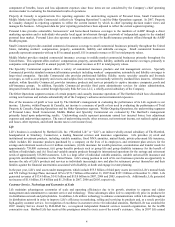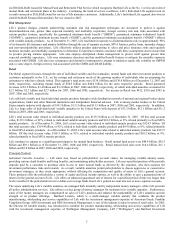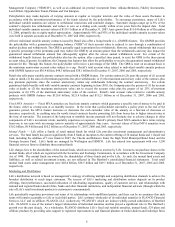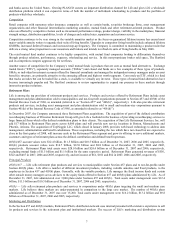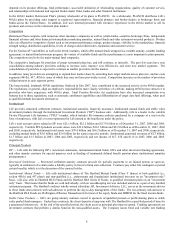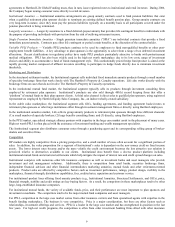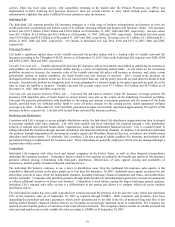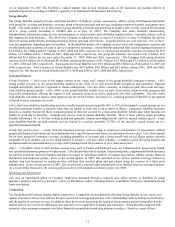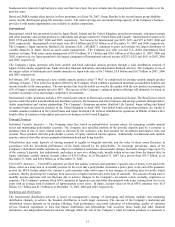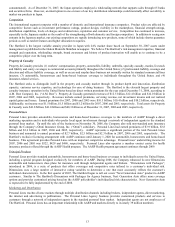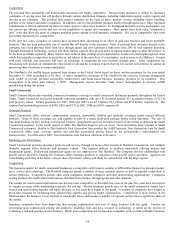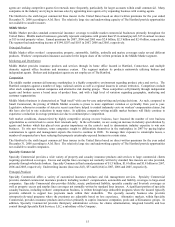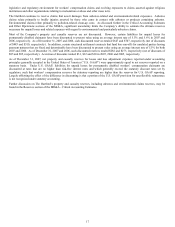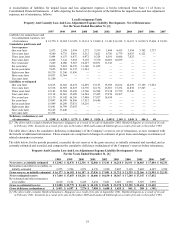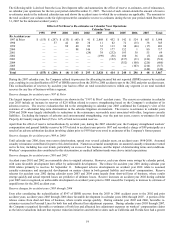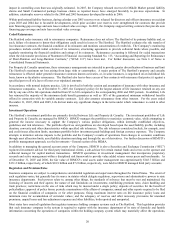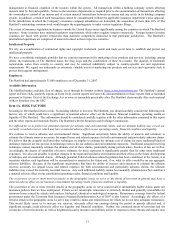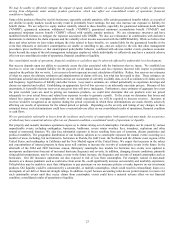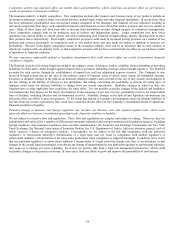The Hartford 2007 Annual Report Download - page 14
Download and view the complete annual report
Please find page 14 of the 2007 The Hartford annual report below. You can navigate through the pages in the report by either clicking on the pages listed below, or by using the keyword search tool below to find specific information within the annual report.
14
Competition
The personal lines automobile and homeowners businesses are highly competitive. Personal lines insurance is written by insurance
companies of varying sizes that sell products through various distribution channels, including independent agents, captive agents and
directly to the consumer. The personal lines market competes on the basis of price; product; service, including claims handling;
stability of the insurer and name recognition. In addition, carriers that distribute products mainly through agents have either increased
commissions or offered additional incentives to those agents to attract new business. To distinguish themselves in the marketplace, top
tier carriers are offering on-line and self service capabilities to agents and consumers. More agents have been using “comparative
rater” tools that allow the agent to compare premium quotes among several insurance companies. The use of comparative rater tools
has further increased price competition.
In the past two years, a number of carriers have increased their advertising in an effort to gain new business and retain profitable
business. This has been particularly true of carriers that sell directly to the consumer. Sales of personal lines insurance directly to the
consumer have been growing faster than sales through agents and now represent a little more than 20% of total industry premium.
Through information technology, carriers will likely further segment their pricing plans to expand market share in what they believe to
be the most profitable segments. Many insurers have reduced their writings of new homeowners business in catastrophe-exposed states
which has intensified competition in areas that are not subject to the same level of catastrophes, such as states in the Midwest. Carriers
with more efficient cost structures will have an advantage in competing for new business through price. Some competitors are
introducing new products at substantially reduced rate levels and the Company expects that top tier carriers will continue to capture an
increasing share of industry revenues and profits.
The Hartford is the twelfth largest personal lines insurer in the United States based on direct written premiums for the year ended
December 31, 2006 according to A.M. Best. A major competitive advantage of The Hartford is the exclusive licensing arrangement
with AARP to provide personal automobile, homeowners and home-based business insurance products to its members. This
arrangement is in effect until January 1, 2020. Management expects favorable “baby boom” demographics to increase AARP
membership during this period.
Small Commercial
Small Commercial provides standard commercial insurance coverage to small commercial businesses primarily throughout the United
States. Small commercial businesses generally represent companies with up to $5 in annual payroll, $15 in annual revenues or $15 in
total property values. Earned premiums for 2007, 2006 and 2005 were $2.7 billion, $2.7 billion and $2.4 billion, respectively. The
segment had underwriting income of $508, $422 and $232 in 2007, 2006 and 2005, respectively.
Principal Products
Small Commercial offers workers’ compensation, property, automobile, liability and umbrella coverages under several different
products. Some of these coverages are sold together as part of a single multi-peril package policy called Spectrum. The sale of
Spectrum business owners’ package policies and workers’ compensation policies accounts for most of the written premium in the Small
Commercial segment. In the fourth quarter of 2006, The Hartford began to roll out a new “Next Generation Auto” product to Small
Commercial customers. Similar to The Hartford's Next Generation Auto product for AARP business, Next Generation Auto for Small
Commercial offers more coverage options and provides customized pricing based on the policyholder’ s individualized risk
characteristics. As of the end of 2007, Next Generation Auto had been rolled out to 44 states.
Marketing and Distribution
Small Commercial provides insurance products and services through its home office located in Hartford, Connecticut, and multiple
domestic regional office locations and insurance centers. The segment markets its products nationwide utilizing brokers and
independent agents. Brokers and independent agents are not employees of The Hartford. The Company also has relationships with
payroll service providers whereby the Company offers insurance products to customers of the payroll service providers. Agencies are
consolidating such that, in the future, a larger share of premium volume will likely be concentrated with the larger agents.
Competition
The insurance market for small commercial businesses is competitive with insurers seeking to differentiate themselves through product,
price, service and technology. The Hartford competes against a number of large, national carriers as well as regional competitors in
certain territories. Competitors include other stock companies, mutual companies and other underwriting organizations. Companies
writing business for small commercial business distribute their products through agents and other channels.
The market for small commercial business has become more competitive as favorable loss costs in the past few years have led carriers
to expand coverage while maintaining relatively flat pricing. Written premium growth rates in the small commercial market have
slowed and underwriting margins will likely decrease as loss costs have begun to rise again. A number of companies have sought to
grow their business by increasing their underwriting appetite and paying higher commissions. Competition is most intense in the
Midwest since the business is less exposed to catastrophe losses and because a number of regional carriers have a significant share of
the market.
Insurance companies have been improving their pricing sophistication and ease of doing business with the agent. Carriers are
developing more sophisticated pricing and predictive modeling tools and have invested in technology to speed up the process of
evaluating a risk and quoting on new business. While price competition has increased as companies seek to retain profitable business,


